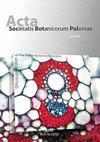Tissue Culture Techniques for the Production of Interspecific Hybrids in Poland: History and Achievements
IF 1.1
4区 生物学
Q3 PLANT SCIENCES
引用次数: 0
Abstract
Interspecific hybridization is a significant plant evolutionary process and, concomitantly, a frequently used method to broaden the genetic variability of species and genetically improve crops. However, in distant crosses, many prezygotic and postzygotic barriers are encountered that prevent free, uncontrolled gene flow between species. Therefore, various experimental methods exploiting tissue culture, such as in vitro fertilization, embryo rescue, and protoplast fusion, have been developed to raise hybrids that cannot be obtained naturally through conventional approaches. Professor Maciej Zenkteler of the Adam Mickiewicz University in Poznań pioneered the use of tissue culture in Poland to overcome barriers to sexual crossing. In the mid-1960s, he employed in vitro pollination in which pollen grains were directly applied onto the surface of exposed ovules as the primary method to bypass prezygotic barriers and in vitro culture of isolated ovules and developing embryos (embryo rescue) to overcome post-zygotic barriers. These approaches proved effective for species possessing numerous ovules and large placentas, such as representatives of the families Caryophyllaceae, Solanaceae, and Brassicaceae. Soon thereafter, these methods were extended to other Polish institutes and universities and applied for crop improvement, such as for the production of intergeneric hybrids between Salix and Populus species, resynthesis and broadening of the genetic variability of oilseed rape ( Brassica napus L.), and the generation of new interspecific hybrids of Allium . In the late 1970s, Professor Zenkteler was the first to undertake protoplast fusion. At that time, it appeared that no incompatibility could exist at the fusion level and that somatic hybridization would supersede the possibilities offered by sexual hybridization; however, the reality turned out to be slightly harsh. Nonetheless, successful regeneration of different interspecific hybrids of potato, tomato, or gentians has been achieved by Polish research groups thus far.波兰种间杂交种生产的组织培养技术:历史和成就
种间杂交是一个重要的植物进化过程,同时也是拓宽物种遗传变异性和转基因作物的常用方法。然而,在遥远的杂交中,会遇到许多合子前和合子后的障碍,阻止物种之间自由、不受控制的基因流动。因此,利用组织培养的各种实验方法,如体外受精、胚胎拯救和原生质体融合,已经被开发出来,以培育无法通过传统方法自然获得的杂交种。波兹南Adam Mickiewicz大学的Maciej Zenkteler教授率先在波兰使用组织培养来克服性跨越的障碍。在20世纪60年代中期,他采用了将花粉粒直接施加在裸露胚珠表面的体外授粉作为绕过受精前障碍的主要方法,并采用了分离胚珠和发育中胚胎的体外培养(胚胎拯救)来克服受精后障碍。这些方法被证明对拥有大量胚珠和大胎盘的物种有效,例如石竹科、茄科和十字花科的代表。此后不久,这些方法被推广到波兰其他研究所和大学,并应用于作物改良,例如生产柳和杨属物种之间的属间杂交种,重新合成和扩大油菜(Brassica napus L.)的遗传变异性,以及产生新的葱属种间杂交种。20世纪70年代末,Zenkteler教授是第一个进行原生质体融合的人。当时,似乎在融合水平上不存在不亲和性,体细胞杂交将取代性杂交提供的可能性;然而,事实证明有点残酷。尽管如此,到目前为止,波兰研究小组已经成功地再生了马铃薯、番茄或龙胆的不同种间杂交种。
本文章由计算机程序翻译,如有差异,请以英文原文为准。
求助全文
约1分钟内获得全文
求助全文
来源期刊
CiteScore
2.00
自引率
10.00%
发文量
18
审稿时长
1 months
期刊介绍:
The journal has been published since 1923 and offers Open Access publication of original research papers, short communications, and reviews in all areas of plant science, including evolution, ecology, genetics, plant structure and development, physiology and biochemistry.

 求助内容:
求助内容: 应助结果提醒方式:
应助结果提醒方式:


